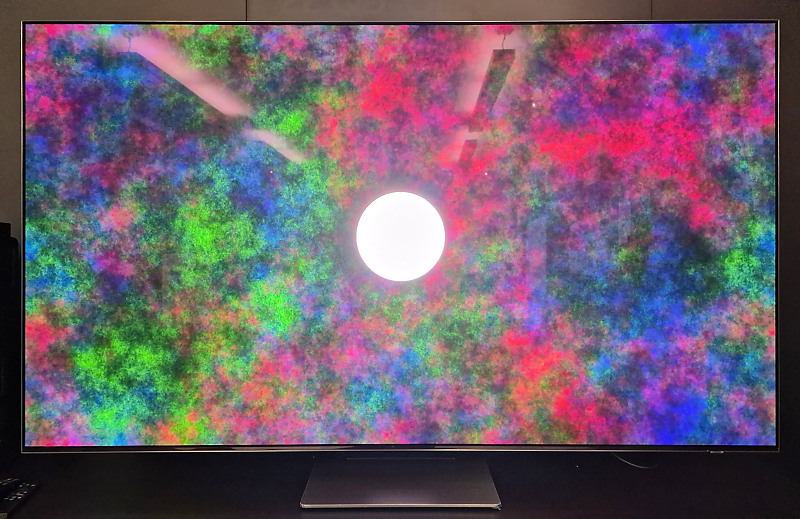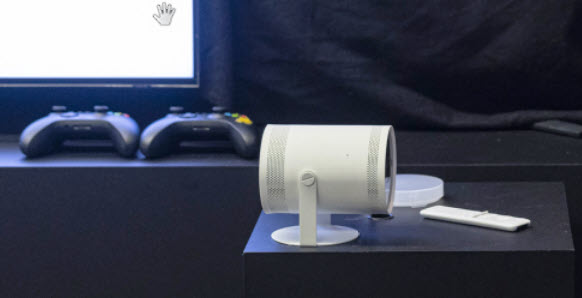Samsung, as it often does at CES and other big trade shows, had what it calls an Innovation room to show journalists the latest technologies away from the crowds on the show floor.

This year, there were five technology points that they were explaining (and I gave a talk about 8K which I summarised last week Why 8K TV is Going to Develop)
- Improvements in miniLED performance in the latest Samsung 2022 Neo QLED sets
- The improved colour volume in the QD-OLED panel
- How colour accuracy is possible in TVs with Pantone’s endorsement
- Improved cloud gaming performance in 2022 Samsung Neo QLED sets
- New features for the Freestyle projector
The sessions were detailed and the whole tour took up to one and a half hours, so what is here is just a brief summary. I’ll cover them in the order they were presented.
MiniLED, which Samsung includes in its Neo QLED sets (as there are other features as well as miniLED) gives great contrast, but tends to suffer from ‘blooming’ – that is to say, a kind of halo around bright points on the screen. In the past, the firm’s engineers had to compromise – they could optimise to minimise the blooming, but this tended to raise the black level. On the other hand, they could optimise the black level at the expense of blooming.
For 2022, the sets have extended black light control as the processing is now done with 14 bits of control compared with 2021 sets at 12 bit. This added accuracy and, effectively, extends the dynamic range of the backlight, meaning less compromise.
Samsung also used a single ‘filter’ function to control the backlights in 2021. This could be narrow or broad, but had to be applied to all the areas of the display. In 2022, the sets can support more than one filter, so you might use a broad filter on one side of the screen and several narrow filters on the other. This visibly improves the haloing performance. The content was shown on four screens – a reference monitor, a Samsung Neo QLED 2022 set and two ‘top of the range’ competitors (with the design and brands hidden). One test journalist correctly guessed which was which of the two unbranded sets! The new filter clearly out-performed the competitors although also clearly not as good as the reference for blooming (as you would expect).
QD OLED
The next demo was by Florian Friedrich of FF Pictures – a real specialist in HDR. As well as chairing the ICDM HDR measurement committee, he has personally remastered 30 movies for HDR viewing in the home. (and has done some great work on improved methods of measuring displays that I am planning to write up for another DD)
He had three displays – the Sony ‘top of the range’ professional dual panel monitor, a Samsung QD-OLED set and another based on WOLED. He showed video content on each and clearly showed how the QD-OLED maintained saturation much more accurately than the WOLED panel and amazingly close to the Sony monitor (which costs €30K and couldn’t be sold as a TV because of power consumption). There was one particular scene showing some light coloured rocks by the sea. When the sun was in the cloud, all three sets looked very similar, but when the sun came out, the Sony was brighter, but the Samsung nearly matched it for saturation, if not for brightness. The WOLED panel, on the other hand, looked washed out as brightness was boosted at the expense of saturation.
Friedrich pointed out that seen without the reference set, the WOLED TV had what most would consider a great picture, but when it was side-by-side, you could see what you would be missing.
 The reflections on this display have made this test pattern of Friedrich’s look not as good as it does in reality. Image:Meko
The reflections on this display have made this test pattern of Friedrich’s look not as good as it does in reality. Image:Meko
Accurate Pantone Colours on a TV?
 Next to speak was Francesco Tomasello, VP of Sales for Pantone, a company famous for its colour system and science. It also owns X-Rite and the Munsell system so it has a substantial business in colour management. The firm has, for some time, evaluated printers and professional monitors and issued ‘Pantone Validated’ approvals. It was surprised when Samsung asked the firm to evaluate a Neo QLED TV as it had never looked at a TV before. The company found that not only could the set cover 90.47% of the Pantone colours (the professional monitors get to 94%) but with ‘high precision’ for 50% of the colours, 25% with an accuracy of Delta E <2 and 25% with wider tolerance. Pantone was impressed that a consumer level set could achieve such accuracy.
Next to speak was Francesco Tomasello, VP of Sales for Pantone, a company famous for its colour system and science. It also owns X-Rite and the Munsell system so it has a substantial business in colour management. The firm has, for some time, evaluated printers and professional monitors and issued ‘Pantone Validated’ approvals. It was surprised when Samsung asked the firm to evaluate a Neo QLED TV as it had never looked at a TV before. The company found that not only could the set cover 90.47% of the Pantone colours (the professional monitors get to 94%) but with ‘high precision’ for 50% of the colours, 25% with an accuracy of Delta E <2 and 25% with wider tolerance. Pantone was impressed that a consumer level set could achieve such accuracy.
It also validated the set for Pantone’s skintone colour range, something that has only been done for professional displays before. That has become a really important factor in recent years and, of course, is critcal for companies in areas such as cosmetics. Tomasello said that in the past much of the real world discussion with clients in areas like textiles or other industrial products was from a ‘real world’ colour to find a matching digital colour. However, increasingly in recent years the drive was coming initially from a digital colour to then work out how to get that colour in the real world.
(It occurs to me that if this is happening – products in our real world may get less colourful as the initial colour is from a more restricted gamut).
Faster, Faster in the Cloud
The next station showed how Samsung has implemented new processing, in particular with faster memory access, in its 2022 Neo QLED sets. Samsung sees cloud gaming as an important TV application and has been working to make performance better. If overall system latency is 200ms, users get angry and frustrated. At 150ms, the firm said, games are playable but not happily. At 100ms latency, users are comfortable and enjoy playing. In the new sets, Samsung can get to to under 100ms from around 130ms last year if gaming mode is selected. A demo was made using one with and one without the new specification and the difference was clear.
The demo also showed how AI based up-scaling could be used to improve the picture with differences clearly visible on the 8K set compared to the 4K set running the same content. Admittedly, this added back some ms (Samsung was wary about publishing exact numbers) but the result was from just under 100ms to ‘just over’.
Samsung explained that it had boosted the ‘AI cores’ in the chipset with four extra to support this gaming upscaling in 2022.
Freestyle
Samsung also had some new features that it is working towards on the Freestyle projectors, but is not ready for us to release details*.
 The Freestyle projector. Image:Samsung
The Freestyle projector. Image:Samsung
And finally…
As a journalist, you have to be a bit sceptical about this kind of demonstration, but I spent several days with the engineers and Florian and I asked a lot of questions to the Samsung engieers, so I am very comfortable about what I saw. That’s why I have written it up with more detail than I would normally. Unfortunately, Samsung does not allow photography in the sessions, and although they had their own photographer taking a lot of pictures, they would not release more than the one I published last week. (BR)
* some info was in an earlier version of the article as we had not been informed of an embargo on the information.

